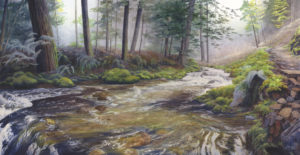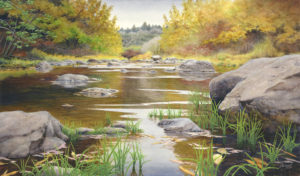In this blog, ICL’s 2018 artist in residence, watercolorist Jessica L. Bryant, talks about her experiences and aims as a watercolor painter. We’re honored to have her amazing paintings featured in our work this year, and appreciate that she devoted her residency to celebrating our Idaho wild and scenic rivers during the 50th anniversary of the Wild and Scenic Rivers Act. If you are near Sandpoint, go see her full year-end exhibit which runs through Dec. 30. Jessica’s paintings give a near-photographic impression yet are distinctly skillful, luminous watercolors representing her take on a landscape. Check out her work at www.jessicabryant.com. Our artist in residence program, sponsored by ARTA River Trips, explores the nexus between art and nature. – MBW
When people see my work for the first time, I typically hear something akin to "Wait, that’s watercolor? I thought it was a photograph." I appreciate the implied compliment, yet there’s so much more to painting representational landscapes beyond making them look photographic, and I’d like to share some thoughts on that.
When it comes to making something look "real," it’s a matter of painting the right shape in the right value (light or dark), color, and location. If you do that, it will look photographic, and this is actually quite teachable, though it can take a lot of practice. Truly, photorealism is not the challenge. Learning to see accurately is much harder. As the artist Robert Irwin said, "Seeing is forgetting the name of the thing one sees." Meaning, you’re not truly seeing if part of your brain is also busy labeling and categorizing.

Seeing vs. Labeling
Early childhood in our culture is filled with left brain dominant tasks: labeling colors, sorting shapes, creating patterns. These skills serve us very well, but they can be a liability when it comes to art. We become excellent symbol makers. When asked to draw a tree, most of us will make something shaped vaguely like a triangle or lumpy circle, colored green, with a brown rectangular shape underneath. No tree in nature looks anything like this symbol, yet we can all recognize it. Symbols are efficient communication and serve a useful purpose, but we have to learn to look with innocent eyes in order to draw accurately instead of reverting to symbol generation. The goal is to observe shape, value, and color without identifying the subject.

Controlling the Paint
Next is learning to articulate what you see in these same terms and then develop an ability to control the medium to replicate this. Imagine trying to paint something when you can’t articulate what you’re actually trying to paint, with a medium that doesn’t allow for covering mistakes. This is where 90% of my students are when they come to me – and where watercolor gets a bad reputation. True, it’s not as forgiving as oil or acrylic, which allow for easier adjustments. In watercolor, highlights are achieved by preserving the white of the paper. Its transparent nature necessitates planning and problem solving to achieve the right look, and quite a bit of painting negative space, the area around a subject, instead of the subject itself. Consider grass with a dark background; in oil or acrylic, you’d likely paint the background first, then layer the blades of grass on top. In watercolor, you paint the grass first, then the dark background is put in carefully around the shapes of the grass blades. It can be tedious, which is perhaps why watercolor is so often used in a more loose, flowing manner.

Detail, Mood and Structure
But just like in literature where we enjoy poetry, short stories, and novels, watercolor can be used in a variety of ways to great effect. In large paintings, I relish finding ways to combine these genres, tight accuracy in some areas, and in others, a wetter application, allowing the pigments to flow for that lush, luminous effect that is unique to watercolor. The tighter areas give the viewer the illusion that the entirety is fully detailed, while the looser mimics our peripheral vision; together, this is like our natural way of seeing.
Beyond drawing accuracy and attractive paint application, one aims to capture the essence of a place, its mood. This sounds elusive, but there are tangible realities that invoke specific feelings and learning to apply them is just another teachable skill.
There are universal parallels between art forms, and the structure that supports each is its composition. Composition is the holy grail, and the success of any work of art depends on it. I could easily write for days on composition, but for now I’d like you to understand it as the underlying abstract design of a painting.

The Real Challenge
In photorealistic work, there are two paintings going on in one: an abstract painting and a realistic one. Here lies the real challenge: all the beautiful color, technique and mood in the world won’t make a great painting.
To achieve success in composition, technique and mood in the same painting, with a subject that bears universal appeal, is to make truly great work. This challenge is what brings me back to the studio day after day.
– Jessica L. Bryant

